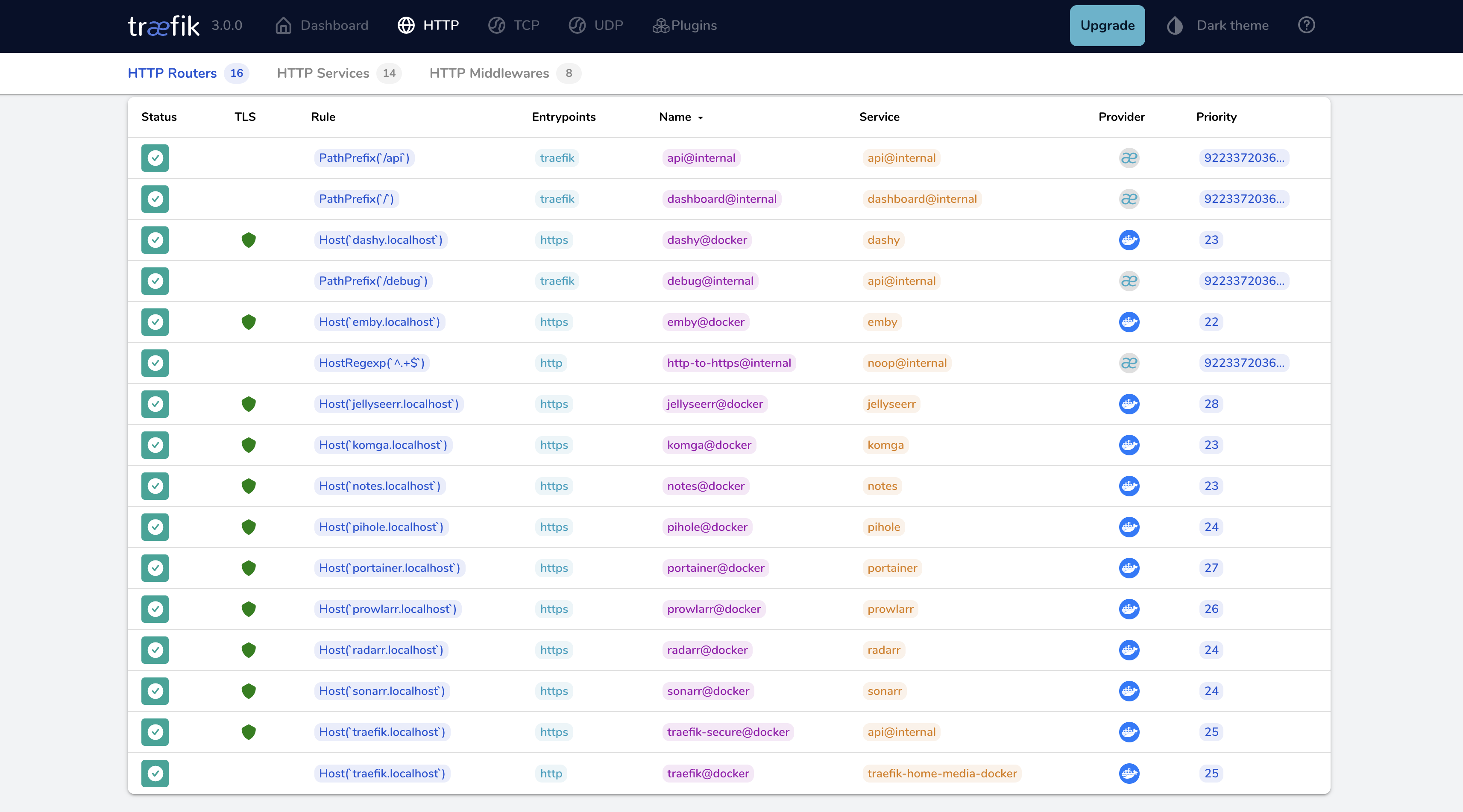Traefik
This is definitely one of the better reverse proxy solutions I have ever used. Traefik is just magical and they explain their product better than I ever could:
Traefik is an open-source Edge Router that makes publishing your services a fun and easy experience. It receives requests on behalf of your system and finds out which components are responsible for handling them.
What sets Traefik apart, besides its many features, is that it automatically discovers the right configuration for your services. The magic happens when Traefik inspects your infrastructure, where it finds relevant information and discovers which service serves which request. source
Basically when you spin up your containers, as long as you have the right labels on them, Traefik knows about them, and serves them up accordingly. It's very cool and one of the best parts about this entire setup is almost every compose file is already presetup and tested in a local and server environment with Traefik in mind as a first class citizen.
Do I have to use it?
Traefik is completely optional to enable, but when you do, every container is setup to be hit with a direct hostname (no port required) like https://*.localhost or https://<container_name>.localhost or further https://sonarr.localhost.
Certificates
Traefik comes with a nice little feature and integration with acme and Let's Encrypt inside of it to sign certificates and give you a solid SSL experience. Since it is a reverse proxy and Load balancer, you can sign a single wild card cert and all of your containers will use it without having to configure each container to work with static SSL certs.
Setup
First and foremost -- READ THE DOCS - they are going to be your guiding light if you veer away from this project or do your own compose files.
Every container is already setup for basic use of traefik and SSL out of the box, all you have to do is enable traefik.
Traefik retrieves the private IP and port of containers from the Docker API.
Port detection for private communication works as follows:
- If a container exposes a single port, then Traefik uses this port.
- If a container exposes multiple ports, then Traefik uses the lowest port. E.g. if
80and8080are exposed, Traefik will use80. - If a container does not expose any port, or the selection from multiple ports does not fit, then you must manually specify which port Traefik should use for communication by using the label
traefik.http.services.<service_name>.loadbalancer.server.port
See Traefik Docs for more information.
Enable Traefik Project Wide for Scripts
# In your .env file
## Or just individually comma separate your services.
COMPOSE_PROFILES=bookstack,dashy,........ # (truncated for readability)
### ENABLE TRAEFIK - keep COMPOSE_PROFILES above
COMPOSE_PROFILES=${COMPOSE_PROFILES},traefik"
Run the startup script
./scripts/startup.sh jellyfin # jellyfin is just a media server example
# you will see an echo of your enabled profiles
COMPOSE_PROFILES=bookstack,dashy,duplicati,...,traefik
## containers will start or pull
- Just Traefik Commands
| Type | Command |
|---|---|
| Start | docker compose up traefik -d |
| Shutdown | docker compose down traefik |
- Once started, Traefik should be hit from this url:
| URL | |
|---|---|
| Non-SSL | http://localhost:8080/dashboard |
| via Reverse Proxy | https://traefik.localhost/dashboard |
| Image | traefik:v3.0 |
Traefik Dashboard

Traefik Example Docker Compose
services:
traefik:
image: traefik:v3.0
container_name: ${TRAEFIK_CONTAINER_NAME}
restart: unless-stopped
security_opt:
- no-new-privileges:true
networks:
- homelab
ports:
- 80:80
- 443:443/tcp
- 443:443/udp # Uncomment if you want HTTP3
- ${TRAEFIK_DASHBOARD_PORT}:8080
env_file:
- ./.env
- ../../.env
environment:
# CF_DNS_API_TOKEN_FILE: /run/secrets/cf_api_token # note using _FILE for docker secrets
CF_DNS_API_TOKEN: ${CF_DNS_API_TOKEN} # if using .env
TRAEFIK_DASHBOARD_CREDENTIALS: ${TRAEFIK_DASHBOARD_CREDENTIALS}
NETLIFY_TOKEN: ${TRAEFIK_NETLIFY_TOKEN}
# secrets:
# - cf_api_token
volumes:
- /etc/localtime:/etc/localtime:ro
- /var/run/docker.sock:/var/run/docker.sock:ro
- ../../traefik-data/traefik.yml:/traefik.yml:ro
- ../../traefik-data/acme.json:/acme.json
- ../../traefik-data/config.yml:/config.yml:ro
labels:
- "traefik.enable=true"
- "traefik.docker.network=home-media-docker_homelab"
- "traefik.http.routers.${TRAEFIK_CONTAINER_NAME}.entrypoints=http"
- "traefik.http.routers.${TRAEFIK_CONTAINER_NAME}.rule=Host(`${TRAEFIK_CONTAINER_NAME}.${PROJECT_HOSTNAME}`)"
# - "traefik.http.middlewares.traefik-auth.basicauth.users=${TRAEFIK_DASHBOARD_CREDENTIALS}"
- "traefik.http.middlewares.traefik-https-redirect.redirectscheme.scheme=https"
- "traefik.http.middlewares.sslheader.headers.customrequestheaders.X-Forwarded-Proto=https"
- "traefik.http.routers.${TRAEFIK_CONTAINER_NAME}.middlewares=traefik-https-redirect"
- "traefik.http.routers.${TRAEFIK_CONTAINER_NAME}-secure.entrypoints=https"
- "traefik.http.routers.${TRAEFIK_CONTAINER_NAME}-secure.rule=Host(`${TRAEFIK_CONTAINER_NAME}.${PROJECT_HOSTNAME}`)"
# - "traefik.http.routers.${TRAEFIK_CONTAINER_NAME}-secure.middlewares=traefik-auth"
- "traefik.http.routers.${TRAEFIK_CONTAINER_NAME}-secure.tls=true"
- "traefik.http.routers.${TRAEFIK_CONTAINER_NAME}-secure.tls.certresolver=${TRAEFIK_TLS_CERTRESOLVER}"
- "traefik.http.routers.${TRAEFIK_CONTAINER_NAME}-secure.tls.domains[0].main=${PROJECT_HOSTNAME}"
- "traefik.http.routers.${TRAEFIK_CONTAINER_NAME}-secure.tls.domains[0].sans=*.${PROJECT_HOSTNAME}"
- "traefik.http.routers.${TRAEFIK_CONTAINER_NAME}-secure.service=api@internal"
## Middlewares
- ${TRAEFIK_DASHBOARD_AUTHENTIK_MIDDLEWARE:-}
profiles:
- all
- traefik
Traefik Example .env file
####### TRAEFIK/ACME ############
TRAEFIK_CONFIG_FILE_LOCATION="../../traefik.yml"
TRAEFIK_CONTAINER_NAME="traefik"
TRAEFIK_DASHBOARD_PORT="8080"